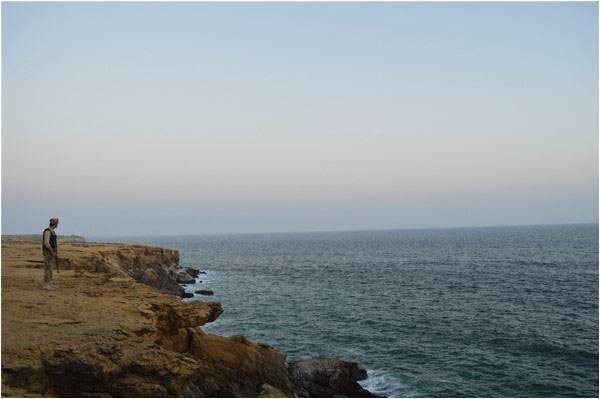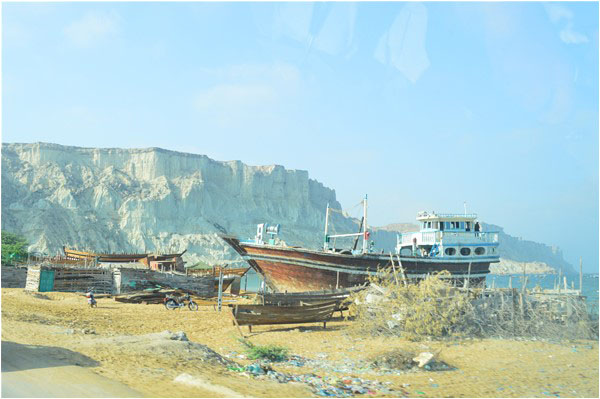
It is one thing to hear that Chinese nationals in Gwadar and site for the China-Pakistan Economic Corridor (CPEC) get heightened, foolproof security and it is quite another to experience that security firsthand. And that is indeed what I can report as the Center for Research and Security Studies recntly arranged a tour of Gwadar for its Chinese counterparts from the Chinese Association for Friendship. Right off the bat, getting the security clearance was a comprehensive process. The smallest discrepancies or concerns were flagged and investigated until they reached a logical conclusion. Once the permits were squared away, and the identities of all Pakistani nationals had been confirmed against their National Identity Card numbers, we were cleared to visit. This is not to say that one cannot visit Gwadar as a Pakistan national; our clearance was required to be able to visit sensitive, CPEC-related areas. Once in the city, we were provided a military convoy that was responsible for all of our movement within Gwadar and stood guard every second the contingent spent in the city. Its presence was palpable, pervasive and persistent. When we spoke to our Chinese counterparts, not only did they express their gratitude, but commented on how impressed they were by the level of concern Pakistan had for their safety and well-being.
Two features are prominent in the port city of Gwadar, a city that is often touted as having the potential to change the destiny of Pakistan, and rightly so. First, there is a sharp contrast between what is promised and what currently exists. You can see signs of construction everywhere, and granted the Chinese vision for CPEC is long-term, well-thought out and meticulously executed. Fresh roads are being paved, the port authority is spotless and fastidiously maintained, the mountain ranges are being carved into to make way or gather construction materials. But by and large, Gwadar is a small town filled with poor fishermen. Second, the military presence is pervasive and the measures impressive. Everywhere we went, the military stood at guard.

It must be said at this stage that the development of Gwadar is a long-term process. The Chinese strategy is informed by millenniums of laser focus, unending patience and a grand vision of China becoming the economic engine of the world. While Gwadar may look dirty, decrepit and dilapidated at the moment, it is also a $46 billion-dollar work in progress. CPEC is not only the name of a corridor. It is a much broader concept of integrating development and diplomacy. All the prospective economic development at the end of the day is aimed at achieving broader harmonious relations at the regional and international levels. Speaking of the military presence in Gwadar, which is a good sign, it can also become suffocating very quickly. Gwadar is a small town, with a population that hovers around 100,000, give or take a few thousand, and there is an argument to be made about how over-militarization can have the opposite effect. There were at least two Armored Personnel Carriers (APCs) visible in the city, and that too creates a sense of imminent threat.
This threat, however, is real, clear and present. Earlier in the year, Pakistani authorities successfully captured an Indian operative in Balochistan with the objective of causing mayhem in a province already affected by a heavy insurgency. Pakistan has already presented dossiers of evidence to the UN, the EU and US State Department officials, including Secretary of State John Kerry, detailing Indian involvement in the destabilizing of Balochistan. With CPEC looming and China’s ever-increasing economic footprint in Eurasia, India’s work is cut out for itself, and seeing CPEC’s progress retarded, repressed or even reversed is at the top of its clandestine operatives’ agenda. This is also directly linked with the need for Indian dominance in South Asia, as it is pivoting to position itself as the next superpower here. Its policy has also shifted dramatically from countering Pakistan to countering China, and the current vitriol against Pakistan is deeply steeped in the need to counter China.
The Chinese have no illusions about India’s need to undermine Pakistan and disrupt CPEC. Conveniently, at the moment it also serves them to try and paint Pakistan in a negative light as it takes the spotlight away from well-documented atrocities in the world’s most heavily militarized region: Kashmir. This was also reflected in a very strong statement by Beijing about Pakistan’s sacrifices in the war on terror, following Modi’s missteps to rope in Russia and China at the BRICS Summit to declare Pakistan the “mothership or terrorism”. The Chinese are cognizant of the Indian agenda, particularly in Balochistan and by extension in Gwadar, but their strategy is not easily swayed. CPEC is just the beginning of a massive Chinese project that attempts to interconnect Europe and Asia through a series of roads and maritime routes. Attempts by foreign powers to undermine this initiative are up against the combined economic and military might of both China, and any country it partners with on this issue, including Pakistan.
Image credit: Zeeshan Salahuddin
The author is a freelance journalist and serves as a senior research Fellow at the Center for Research and Security Studies, Islamabad, and holds a bachelor and master degree in strategic communications from Ithaca College, NY. He can be reached via zeeshan[dot]salahuddin[at]gmail.com and tweets @zeesalahuddin.
Two features are prominent in the port city of Gwadar, a city that is often touted as having the potential to change the destiny of Pakistan, and rightly so. First, there is a sharp contrast between what is promised and what currently exists. You can see signs of construction everywhere, and granted the Chinese vision for CPEC is long-term, well-thought out and meticulously executed. Fresh roads are being paved, the port authority is spotless and fastidiously maintained, the mountain ranges are being carved into to make way or gather construction materials. But by and large, Gwadar is a small town filled with poor fishermen. Second, the military presence is pervasive and the measures impressive. Everywhere we went, the military stood at guard.

It must be said at this stage that the development of Gwadar is a long-term process. The Chinese strategy is informed by millenniums of laser focus, unending patience and a grand vision of China becoming the economic engine of the world. While Gwadar may look dirty, decrepit and dilapidated at the moment, it is also a $46 billion-dollar work in progress
It must be said at this stage that the development of Gwadar is a long-term process. The Chinese strategy is informed by millenniums of laser focus, unending patience and a grand vision of China becoming the economic engine of the world. While Gwadar may look dirty, decrepit and dilapidated at the moment, it is also a $46 billion-dollar work in progress. CPEC is not only the name of a corridor. It is a much broader concept of integrating development and diplomacy. All the prospective economic development at the end of the day is aimed at achieving broader harmonious relations at the regional and international levels. Speaking of the military presence in Gwadar, which is a good sign, it can also become suffocating very quickly. Gwadar is a small town, with a population that hovers around 100,000, give or take a few thousand, and there is an argument to be made about how over-militarization can have the opposite effect. There were at least two Armored Personnel Carriers (APCs) visible in the city, and that too creates a sense of imminent threat.
This threat, however, is real, clear and present. Earlier in the year, Pakistani authorities successfully captured an Indian operative in Balochistan with the objective of causing mayhem in a province already affected by a heavy insurgency. Pakistan has already presented dossiers of evidence to the UN, the EU and US State Department officials, including Secretary of State John Kerry, detailing Indian involvement in the destabilizing of Balochistan. With CPEC looming and China’s ever-increasing economic footprint in Eurasia, India’s work is cut out for itself, and seeing CPEC’s progress retarded, repressed or even reversed is at the top of its clandestine operatives’ agenda. This is also directly linked with the need for Indian dominance in South Asia, as it is pivoting to position itself as the next superpower here. Its policy has also shifted dramatically from countering Pakistan to countering China, and the current vitriol against Pakistan is deeply steeped in the need to counter China.
The Chinese have no illusions about India’s need to undermine Pakistan and disrupt CPEC. Conveniently, at the moment it also serves them to try and paint Pakistan in a negative light as it takes the spotlight away from well-documented atrocities in the world’s most heavily militarized region: Kashmir. This was also reflected in a very strong statement by Beijing about Pakistan’s sacrifices in the war on terror, following Modi’s missteps to rope in Russia and China at the BRICS Summit to declare Pakistan the “mothership or terrorism”. The Chinese are cognizant of the Indian agenda, particularly in Balochistan and by extension in Gwadar, but their strategy is not easily swayed. CPEC is just the beginning of a massive Chinese project that attempts to interconnect Europe and Asia through a series of roads and maritime routes. Attempts by foreign powers to undermine this initiative are up against the combined economic and military might of both China, and any country it partners with on this issue, including Pakistan.
Image credit: Zeeshan Salahuddin
The author is a freelance journalist and serves as a senior research Fellow at the Center for Research and Security Studies, Islamabad, and holds a bachelor and master degree in strategic communications from Ithaca College, NY. He can be reached via zeeshan[dot]salahuddin[at]gmail.com and tweets @zeesalahuddin.

